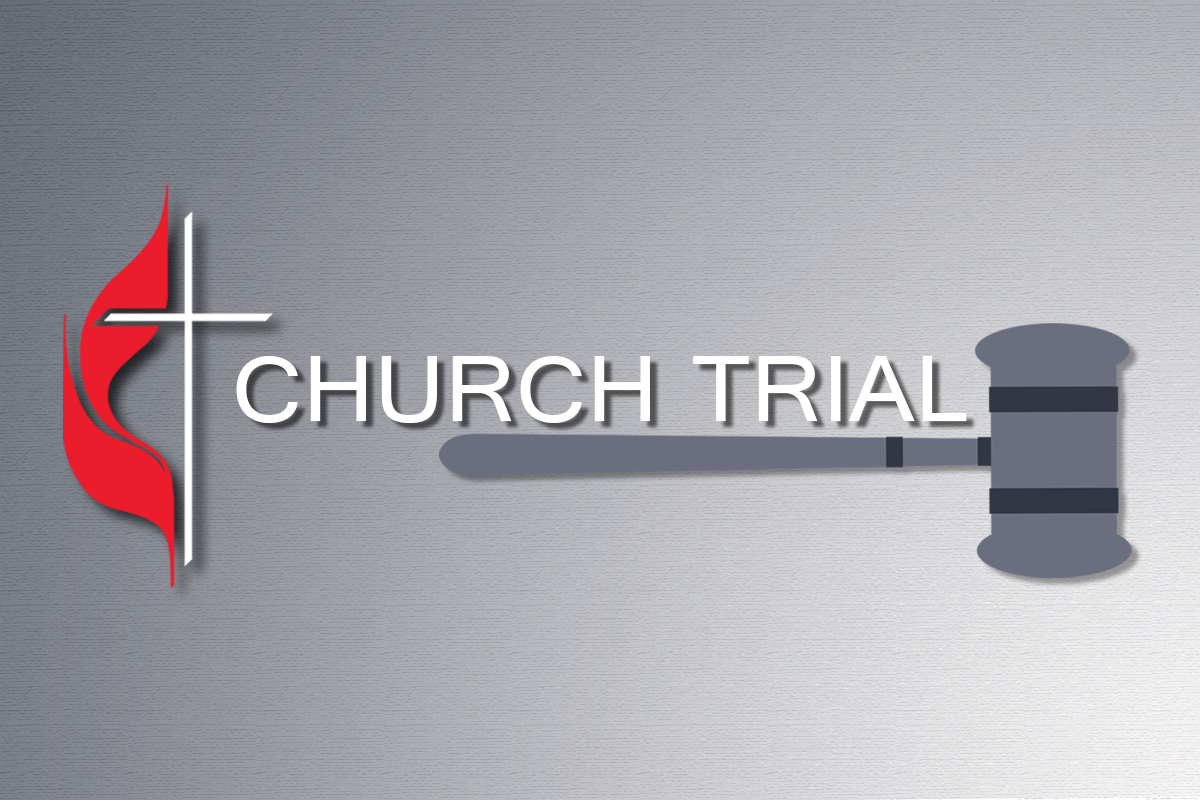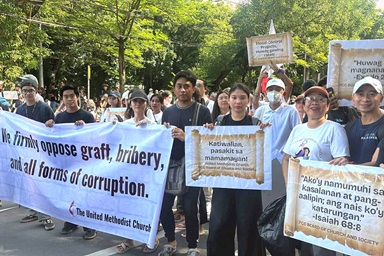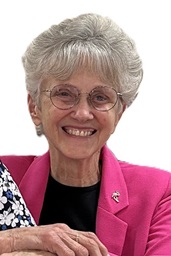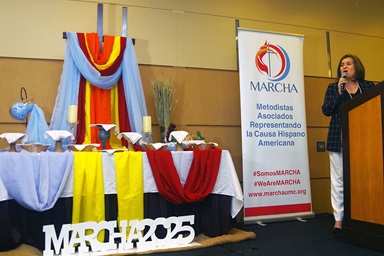The United Methodist Church faces something thought to be unprecedented in its and its Methodist predecessors’ history: the church trial of one of its bishops.
The trial of Bishop Minerva G. Carcaño — who has been under suspension for 18 months — is scheduled to begin Sept. 19 at the offices of Wespath Benefits and Investments in Glenview, Illinois, a Chicago suburb.
United Methodist News plans to cover the trial and post updates at www.umnews.org. In another first in the denomination’s history, the trial will be livestreamed. People can sign up to watch the proceedings. Most of the trial is open to the public, with the exception of jury deliberations.
The Book of Discipline, the denomination’s law book, holds out the possibility of a just resolution being reached at any time before or even during the trial process. So there is no guarantee that the trial will move forward as scheduled.
However, with the church trial set to begin in less than a week, here is a look at some frequently asked questions about the denomination’s judicial complaint process.
How to watch trial
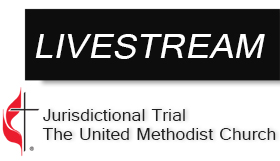
To allow for full transparency, the jurisdictional trial in which Bishop Minerva Carcaño is a respondent will be accessible via a livestream.
Online observers will need to complete a terms-of-use form here. Upon accepting the terms, the livestream will be accessible for each individual session. This process will need to be completed for each court time — morning, afternoon and evening, as applicable.
The trial is scheduled to begin at 9 a.m. U.S. Central time Sept. 19, and at 8 a.m. on subsequent days. The trial is expected to proceed through Sept. 22.
Read press release.
The “Administrative and Judicial Procedures Handbook,” published by the General Council on Finance and Administration, also offers an overview of church trial procedures.
What is a church trial?
Simply put, during a church trial, a person responds to a charge or charges of having violated denominational law as set forth in the Book of Discipline. The church’s judicial process refers to the person facing the charges as “a respondent” and the person or people bringing the complaint of wrongdoing as “complainants.”
The Book of Discipline requires that all United Methodist clergy, which includes bishops, and lay members have a right to a church trial and appeal. That right is so important, it is part of The United Methodist Church’s restrictive rules — meaning even General Conference, the denomination’s top lawmaking body, cannot do away with it.
At the same time, the Discipline also calls a church trial “an expedient of last resort” and encourages a just resolution before a complaint ever gets to that point.
What is a just resolution?
The Discipline defines a just resolution as an agreement “that focuses on repairing any harm to people and communities, achieving real accountability by making things right in so far as possible and bringing healing to all the parties.”
Complainants must be party to any just resolution, and every effort must be made to have complainants agree to the resolution before it takes effect. All parties must sign the resolution and agree on what matters can be disclosed to the public.
Why is Bishop Carcaño on trial?
The charges against the bishop remain undisclosed to the public. Likewise, the complainants’ names also remain confidential.
As in the U.S. court system, the United Methodist judicial process operates under the principle that people are innocent until proven guilty. The United Methodist process also requires the protection of people’s rights to fair process.
Typically, any complaints against bishops are handled within the church region that elected them.
Leaders of the Western Jurisdiction, which elected Carcaño, announced in May that the jurisdiction’s committee on investigation had found reasonable grounds to bring to trial charges that Carcaño violated church law.
Specifically, the committee on investigation brought five charges under the Book of Discipline’s Paragraph 2702.1, which lists the denomination’s chargeable offenses.
How did this situation develop?
Bishops have faced accusations that they have violated church law before. However, in the denomination’s nearly 240-year history, the United Methodist Commission on Archives and History at this point has found no record of a complaint against a bishop actually going to trial.
Because of her age, the 69-year-old Carcaño faces mandatory retirement next year no matter the trial’s outcome.
The denomination’s first Latina bishop in the U.S. has served in ordained ministry for 47 years, including nearly two decades as an episcopal leader. Delegates to the Western Jurisdiction — which encompasses the 12 westernmost U.S. states and the territories of Guam and Saipan — elected Carcaño in 2004.
As bishop, she has led three church regions called annual conferences in succession — Desert Southwest, California-Pacific and, since 2016, California-Nevada.
Western Jurisdiction leaders announced the suspension of Carcaño on March 9 last year while complaints against the bishop were under review. She has been on leave with pay and benefits ever since. In the meantime, retired Bishop Sally Dyck has served as interim episcopal leader of the California-Nevada Conference.
Complaints against bishops and other clergy first undergo a supervisory-response process and are usually resolved at that point. But if unresolved, a complaint under church law can move to a judicial-complaint process. The matter is referred to a counsel for the church, who will then determine if a case can be brought to a committee on investigation.
What is a committee on investigation?
It’s not an exact analogy, but a committee on investigation has a similar role to a grand jury in the U.S. court system. The committee ultimately has responsibility for holding a hearing before determining if evidence supports a bill of charges.
Each jurisdiction elects a committee on investigation, which consists of seven clergy, two lay observers and six alternate members.
One big difference between a committee on investigation and a grand jury is that the committee does not only hear from the counsel for the church and witnesses making the case for charges but also from the person under complaint and that person’s counsel. But ultimately it is up to the committee to determine which witnesses to question, what to ask them and what written material to request.
A committee’s hearing is closed to the public. A committee’s bill of charges may be amended during pre-trial hearings, which also take place under strict confidentiality.
Why has the bishop’s suspension lasted so long?
The suspension of bishops is not unprecedented, and it is not intended to be seen as punitive. While on leave, a bishop receives full pay and benefits, including being able to remain in the assigned episcopal residence.
Carcaño was initially suspended under the Discipline’s Paragraph 413.3(a). That measure allows for a jurisdiction’s college of bishops, in consultation with the jurisdictional committee on episcopacy, to suspend a bishop “when deemed appropriate to protect the well-being of the complainant, the Church and/or bishop.” However, that provision says the suspension is “not to exceed 60 days.”
Her suspension has continued under another provision, the Discipline’s Paragraph 2704.1, which allows for suspension to continue — on the recommendation of a committee on investigation — “pending the conclusion of the trial process.”
In Carcaño’s case, the committee on investigation paused its work when she appealed to the Judicial Council.
In late October last year, the denomination’s top court declined to rule on a judicial complaint against the bishop while the church judicial process is ongoing. However, four of the nine participants in the Judicial Council’s deliberations disagreed with the majority — saying that fair process had been violated and that the bishop should be restored to her office.
But with the Judicial Council ruling, the committee was able to resume its work.
Who will preside at the church trial?
Retired United Methodist Bishop Alfred W. Gwinn, who previously has presided at other church trials, will be the trial’s presiding officer — the equivalent of a judge.
Who represents the church and the respondent?
The Discipline entitles all respondents to be represented by counsel, who must be United Methodist clergy when the respondent is a clergy member. Likewise, a counsel for the church represents the church’s case, much as a prosecutor in a U.S. court represents the state.
Why is the trial taking place outside the Western Jurisdiction?
So far, the Western Jurisdiction has handled the adjudication of the case. The church trial initially was scheduled Aug. 21-25 at First United Methodist Church of Pasadena, California, within the jurisdiction.
However, the Discipline allows the respondent to request a change of venue. The presiding officer ultimately decides whether to grant that request.
In this case, Gwinn agreed to move and reschedule the trial to accommodate the change in venue. The trial is now scheduled to start at 9 a.m. U.S. Central time Sept. 19 at the headquarters of Wespath, the denomination’s pension agency, which is located in the North Central Jurisdiction. The trial is expected to go through Sept. 22.
Bishops in the North Central Jurisdiction are responsible for selecting clergy members in the jurisdiction for the jury pool. The Western Jurisdiction is still responsible for paying for the costs of the trial, including the accommodations for all parties involved in the case as well as the jury pool.
How are members of a church trial jury selected?
In The United Methodist Church, the term used for jury is “trial court.” The 13 members and two alternates will be chosen by the presiding officer — with input from the counsels for the respondent and the church — from a pool of North Central Jurisdiction clergy.
The Discipline requires the pool of potential trial court members to include at least 35 people, with care given to represent racial, ethnic and gender diversity.
The North Central Jurisdiction bishops have selected 38 clergy for the jury pool. The clergy jury pool represents all 10 of the jurisdiction’s conferences, with 63% being people of color and 61% being female.
Subscribe to our
e-newsletter
What happens during the trial?
The presiding officer acts as the judge during the trial but has no authority to determine guilt or innocence. The trial begins with the selection of the trial court. Once selected, both sides of the trial present their case and can question witnesses.
Unlike in U.S. court trials, members of the trial court — including the alternate members — may ask questions during the proceedings. Their ability to ask questions is subject to the presiding officer’s approval.
This is followed by the deliberation of the jury and a determination of guilt or innocence, and other possible outcomes.
If found guilty, the respondent can appeal to a jurisdictional conference committee on appeals. If the committee on appeals renders a ruling adverse to the bishop, she could then appeal to the Judicial Council.
What are the possible outcomes of the trial?
No person can predict the outcome. This is in the hands of the jury. With a guilty verdict, the trial court would have a range of penalties to consider, including the removal of ministerial orders or a lesser penalty.
A bishop removed from office has no claim upon the Episcopal Fund for salary, dwelling, pension or other related benefits from the date of removal. However, the bishop still would keep accrued pension benefits.
While at least nine votes are needed to convict, seven votes by the trial court are necessary to set the penalty.
How have others responded to the bishop’s situation?
Carcaño’s suspension has received pushback. Both MARCHA (Methodists Associated Representing the Cause of Hispanic/Latino Americans), the denomination’s Hispanic/Latino caucus, and ethnic leaders in the California-Nevada Conference have called for Carcaño’s immediate reinstatement.
Meanwhile, a group of California-Nevada Conference clergy said that returning Carcaño to active service without a just resolution or the findings of a church trial “would create a depth of conflict and division that could undermine the mission and ministry” of the conference.
The United Methodist Commission on Religion and Race — the denominational agency that advocates for racial equity in church life — has urged the lifting of the suspension and greater transparency about the nature of the charges the bishop faces.
The United Methodist Commission on the Status and Role of Women — which advocates for the full inclusion of women in church life — has requested to serve as a monitor as the bishop’s case is being adjudicated.
Representatives from MARCHA, Religion and Race and the Status and Role of Women have accepted invitations to be official observers of the trial.
What’s the Council of Bishops’ position on the trial?
The Council of Bishops regards this as a matter within the Western Jurisdiction College of Bishops.
Hahn is assistant news editor for UM News. Contact her at (615) 742-5470 or newsdesk@umcom.org. To read more United Methodist news, subscribe to the free Daily or Friday Digests.

